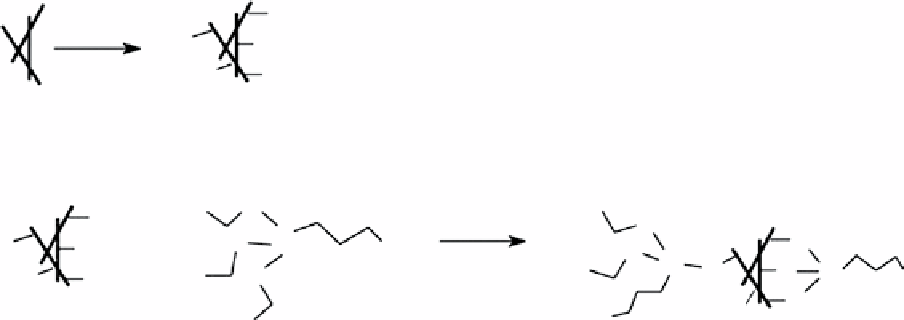Environmental Engineering Reference
In-Depth Information
OH
HCl
HO
OH
HO
OH
ATP
O
H
3
C
H
3
C
OH
343 K
O
O
O
Si
HO
HO
OH
+
NH
2
O
Si
H
3
C
O
O
Si
H
3
C
O
OH
NH
2
O
HO
H
2
N
H
3
C
APTS
M-ATP
figure 16.4
schematic illustration of the surface modification of attapulgite (ATP) by 3-aminopropyltriethoxysilane (APTs).
were through surface adsorption and ligand adsorption, respectively. The organo-mts were used for the adsorption of sr(II). The
adsorption capacity of APTs-mT was 65.6 mg/g, much larger than those of Ca-mT, sds-mT, and HdTmAB-mT (13.23,
26.85, and 3.91 mg/g, respectively) under the chosen conditions. sr(II) removal by Ca-mT was mainly by ion exchange; never-
theless, removal by sds-mT and APTs-mT were through surface adsorption and ligand adsorption, respectively.
APTs was also used for the surface modification of the natural fibrous crystalloid hydrous magnesium aluminum silicate
mineral ATP after being activated with acid, in order to develop an effective adsorbent for aqueous Hg(II) removal (fig. 16.4)
[72]. The adsorption capacities significantly increased from 5 (raw ATP) to 90 mg/g modified ATP (m-ATP), due to the com-
plexation between mercury and the amine functional groups on the m-ATP. Batch adsorption results showed that the adsorption
process was rapid and over 90% of aqueous Hg(II) was removed within 1 h. The efficiency of the adsorbent was found to remain
almost constant over a wide pH range (3-11). Ionic strength and coexisting ions had a slight influence on the adsorption
capacity. Hg(II) adsorbed onto m-ATP could be effectively desorbed in 1:1 (m/m) chlorohydric acid/thiourea solution.
The surface of pyrophyllite mineral was modified by coating with a 3-(2-aminoethylamino) propyl-methyldimethoxysilane
(APmds) coupling agent and the utility of the APmds-modified pyrophyllite was investigated as an adsorbent for removal of Pb(II)
ions from aqueous solutions [73]. The APmds-modified pyrophyllite adsorbed approximately 93% of Pb(II) ions at an initial
concentration of 20 mg/l, while natural pyrophyllite did only 35% under the same conditions. The adsorption of Pb(II) increased with
increasing pH and reached a maximum value in the pH range 6.5-7 and at an initial concentration of 20 mg/l. The presence of some
metal ions such as na
+
, K
+
, Ca
2+
, mg
2+
, fe
3+
, Cu
2+
, mn
2+
, and Zn
2+
and the ligand type of lead complex added to the solution (e.g.,
Pb(OOC-CH
3
)
2
) negatively affected the adsorption of Pb(II) from solutions under the optimized conditions. It was suggested that the
functional amino groups on the surface of APmds-modified pyrophyllite are the main available interaction sites for Pb(II) ions.
The surface modification of sepiolite with [3-(2-aminoethylamino)propyl]trimethoxysilane has been employed for the
adsorption of metal ions [74]. Adsorption of metal ions onto the modified sepiolite varies with the type of metal cations. The
available basic nitrogen centers covalently bonded to the sepiolite skeleton were studied for Co(II), Cu(II), mn(II), Zn(II),
fe(III), and Cd(II) adsorption from aqueous solutions. It was found that the amount of metal ion adsorbed onto the modified
sepiolite increases with an increase in solution equilibrium pH and temperature, whereas it generally decreases with the ionic
strength. The experimental data correlated reasonably well with the Langmuir adsorption isotherm. The ability to adsorb the
cations gave a capacity order of Zn(II)> Cu(II) similar to Co(II)> fe(III) > mn(II) > Cd(II) with affinities of 2.167× 10
−4
,
1.870 × 10
−4
, 1.865 × 10
−4
, 1.193 × 10
−4
, 0.979 × 10
−4
, and 0.445 × 10
−4
mol/g, respectively.
Triethoxy-3-(2-imidazolin-1-yl)propylsilane was modified onto sepiolite clay for the adsorption of HmI (fig. 16.5) [75].
The adsorption of metal ions onto modified sepiolite as an adsorbent increased with increasing pH and temperature, but ionic
strength exhibited no significant effect. The affinity of metal ions for the modified sepiolite surface is a result of both chemical
and electrostatic affinity. The adsorption followed the sequence Co(II) > Cu(II) > Cd(II) > mn(II) > fe(III) > Zn(II).
The compound n-[3-(trimethoxysilyl)propyl]diethylenetriamine (mPdeT) was anchored onto the Amazon kaolinite surface
(KLT) by the heterogeneous route. The adsorption of uranyl on natural (KLT) and modified (KLT(mPdeT)) kaolinite clays was
investigated as a function of the solution pH, metal concentration, temperature, and ionic strength [76]. The ability of these
materials to remove u(VI) from aqueous solution was followed by a series of adsorption isotherms adjusted to a sips equation
at room temperature and pH 4.0. The maximum number of moles adsorbed was determined to be 8.37× 10
−3
and
13.87 × 10
−3
mmol/g for KLT and KLT(mPdeT) at 298 K, respectively.

